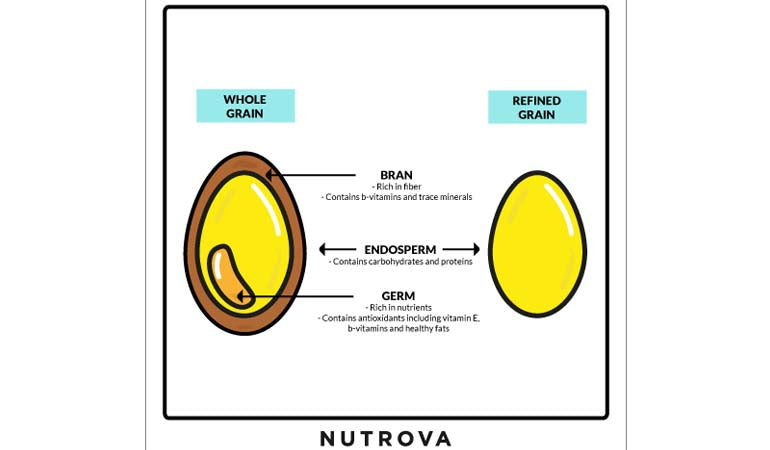Right from your rotis and parathas to your upmas and dosas, grains are an integral part of any Indian’s diet – and let’s not forget all the breads, sandwiches and pizzas we love eating as well!
Shouldn’t we be paying close attention to the grains we consume, then?
Let’s start with understanding the different types.1
Whole grain: A whole grain has three parts – the bran, germ and endosperm.
Multigrain: Refers to the presence of more than one grain, which could be whole or even refined grains.
Refined grain: In refined grain, the bran and the germ of the grain, which are packed with nutrients, have been removed.
Back in the 1800s, people realized that the healthy oils found largely in the germ and bran of whole grains made them spoil faster. Therefore, removing the bran and germ seemed like a good idea at the time, to make them more shelf-stable.
It was only in the 1930s that we began to understand what almost eliminating whole grains from our diet meant for our health.
Whole Grains and Nutrition
Many studies have observed an association between eating whole grains and reducing the risk of diseases, including diabetes and digestive issues. Here’s why:
1] Their Fibre Content
Whole grains contain ∼80% more dietary fibre than refined grains.2
a. Lower blood sugar: The endosperm of cereal grains or seeds contains carbohydrates. The way a whole grain is structured makes it harder to digest the sugars, because of the bran that surrounds the endosperm. That’s good, because your blood sugar would be lower, and with less sugar in blood, insulin levels are lower (high levels otherwise leading to diabetes).3
b. Good bacteria: The carbohydrates that aren’t digested in the small intestine pass into the colon, where they are fermented by “good” bacteria. This produces important molecules that the body needs for our digestive health, like butyrate.3
c. Weight loss: Fibre also promotes weight loss, by increasing satiety (how long you feel full for after a meal). One study reported that in a 20-month period, for every 1 g daily increase in fibre consumption, body weight decreased by 0.25 kg.3, 4
2] Their Vitamins and Minerals:2
a. Whole grains provide a bunch of nutrients like vitamin E, vitamin B, folate, iron magnesium, and selenium.
b. They also contain plant phenolic acids i.e. chemical defence of the plant against pathogens, parasites, and predators.
c. The carotenoids in whole grains have antioxidant properties against free radicals.
d. Plant sterols from whole grains are believed to help us in cholesterol management.
All of these factors work together, with the sum of the parts of a whole grain all conjunctively adding to its health benefits.
Grains at the Grocery Store
“Enriched grains”
Enriched grains are refined grains in which some of the nutrients (that were lost in processing) are added back. Fibre, however, is often left out. Moreover, it’s believed that the proportions of nutrients in whole grains are what makes them work well together.2, 5
“Gluten-free”
Gluten is a natural protein found in wheat, barley and rye. It has gained much attention in the recent past, because of celiac disease (gluten allergy), which affects 1% of the population of western countries.6 It makes sense to avoid it only if you are allergic/intolerant. Rice, oats, quinoa, millet, amaranth, sorghum, teff are naturally gluten-free. For those who are gluten-tolerant, buying “gluten-free” isn’t necessary in order to be healthy.
“Brown bread”
People sometimes assume that brown bread is healthy solely based on its brown appearance. However, this may be because of added colouring agents like caramel or molasses (a brown by-product of refining sugar).7
Whole grains and Indian food
Grains are also a great source of proteins, especially for vegetarians. Being so predominant in Indian cuisine, it’s important that we get the maximum nutritional value by choosing whole wheat grains!
References:
1. Marquart L, et al. Whole Grains and Health. Wiley, 2008.
2. Jonnalagadda SS, et al. The Journal of Nutrition 2011, 141(5): 1011S-1022S.
3. Slavin J. Nutrients 2013, 5(4): 1417-1435.
4. Tucker LA & Thomas KS. J Nutr 2009, 139(3): 576-581.
5. Duyff RL. American Dietetic Association Complete Food and Nutrition Guide, Revised and Updated 4th Edition. Houghton Mifflin Harcourt, 2012.
6. Ramakrishna BS. The Indian Journal of Medical Research 2011, 133(1): 5-8.
7. Beck L. Brown bread vs. white: Are darker foods always better? Health & Fitness 2011. Available from: http://www.theglobeandmail.com/life/health-and-fitness/brown-bread-vs-white-are-darker-foods-always-better/article4183632/




Leave a comment